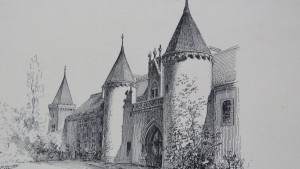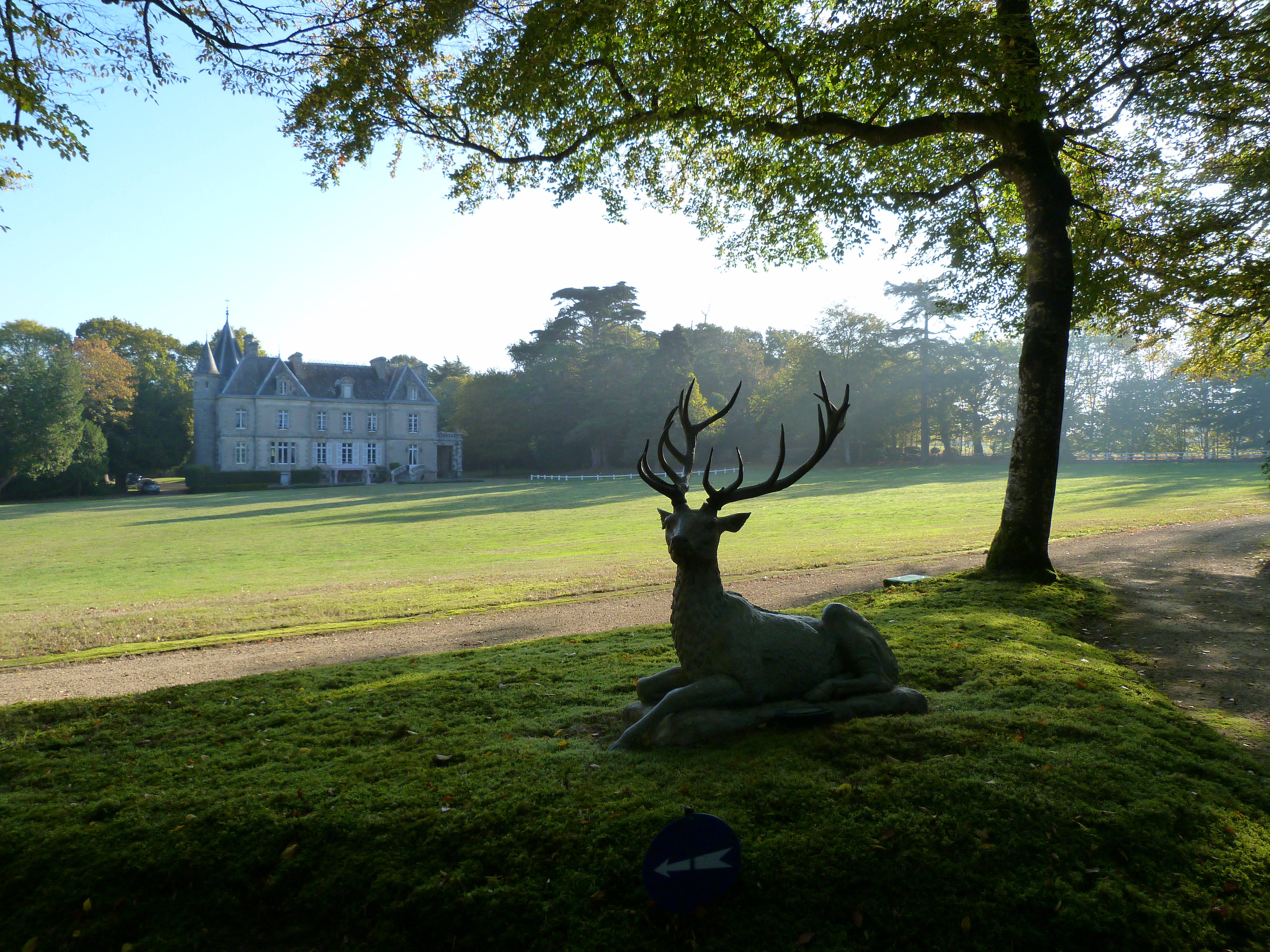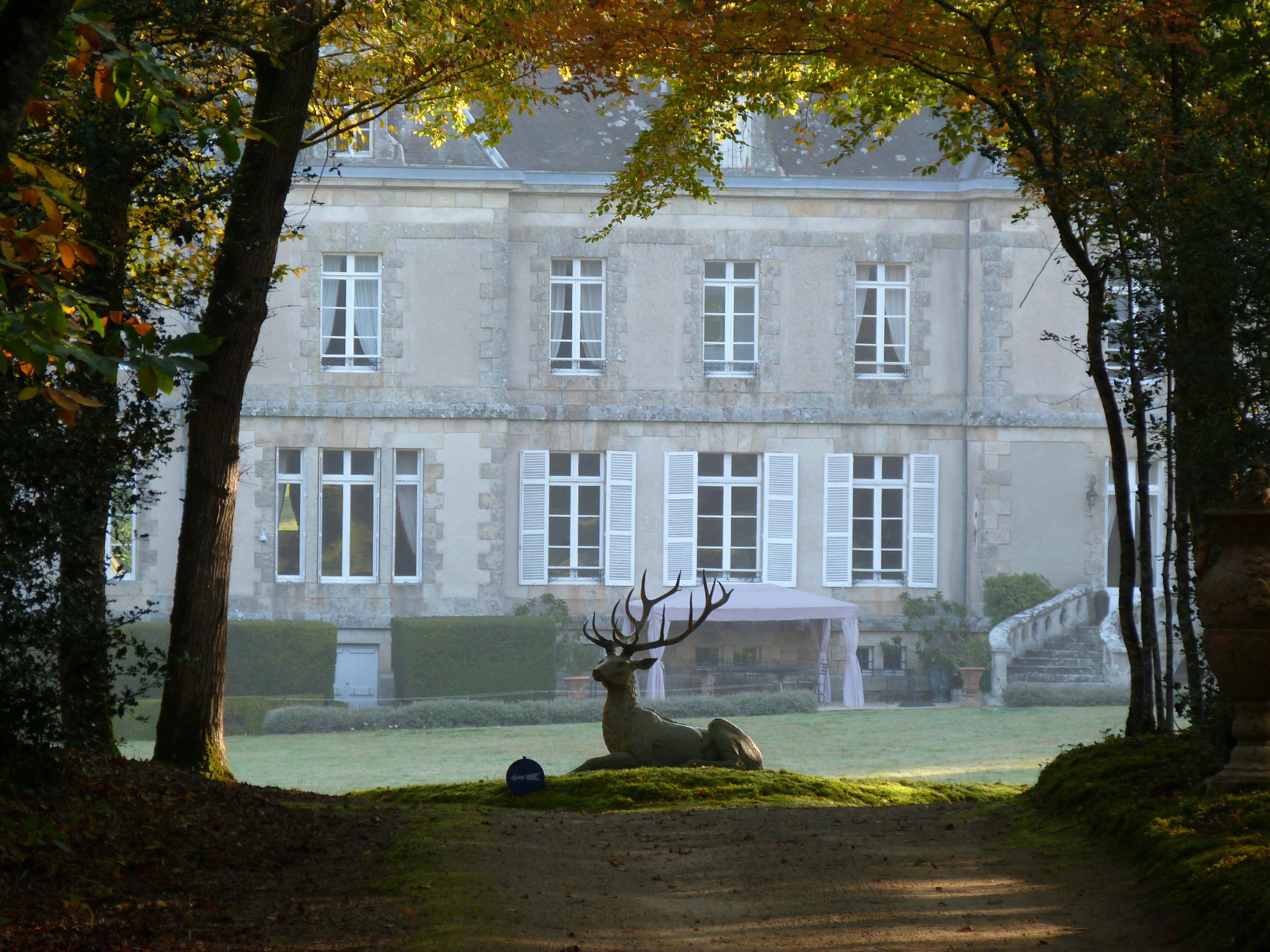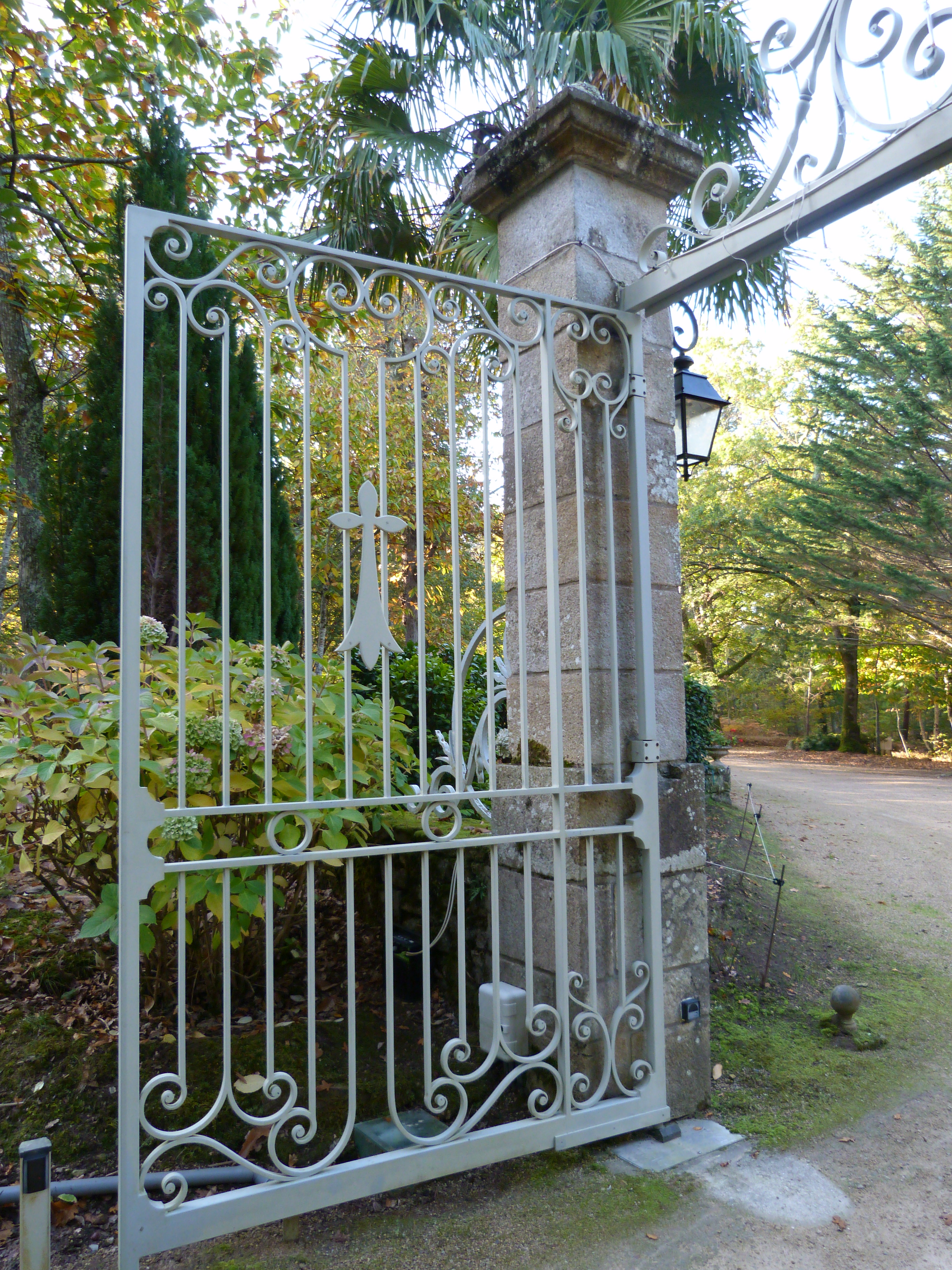This post is also available in:
 Français (French)
Français (French)
CHÂTEAU DU PLESSIS-KAËR
(Taken from the south-east)
The Châteaux of Kergurioné on the la Trinité river, Kérantré and Rosnarho can be found in Crac’h, that of Plessis-Kaër on the Auray river.
KERGURIONNE
Once a powerful lordship, it is said it was once possessed by the Talleyrand. From 1412 to 1570 it remained in the Quirizec family. But this was after being owned by François Dubois and Antoine Muzillac for 50 years. In 1620 it became the principal residence of Pierre Coué, Lord of Salarun who had married Marie Muirizec. Kergurionné remained in the Coué family until the French Revolution.
In 1719, François Coué de Salaran lived in the château. He was one of the main members of the Pontcallec conspiracy and maintained close links with Spain using his boats which were moored in the La Trinité harbour. The conspirators often met in his château. The records of local gossips from the time showed him not to be too cunning. Whatever the truth, one of maréchal Montesquiou’s sleuths wheedled the secret of the conspiracy out of him. Salarun had his wits sufficiently about him to notice the error he had made, his friends were warned in time and got to their boats before the soldiers arrived, raised their sales and escaped the fate to which they were surely destined.
Only a few vestiges of the old Château de Kergurionné remain as evidence of its opulence. The current dwelling is modern, it belongs to Alphgonse Martin, married to the daughter of M. Fonssagrive, the eminent professor of medicine who died in 1884.
KERANTRE
KERANTRE was once just a simple manor. In 1426, it was owned by Jean Hauvering, married to Guillemette de Broerec. In 1446 he was at Lancelot Pezron, ( 1): Pezron Lord of la Salle, Leslay, Penlan and other places; rejected in 1669; ennobled in 1699. The Quifistre (2) family: De Quifistre, Lord of Tremouharn, de Bavalan, marquis of Bois-Geoffroy: d’argent à trois fasces d’azur, later owned it from 1519 à 1604. At this time he moved to a branch of the Gouvello family, which came from the branches of Kériaval and from the marriage of John to Jeanne Bino (1472). The father of Jean, Eon Le Gouvello was lieutenant of the Auray company in 1433, and governor of Guillaume de Blois. Alexis, Lord of Kerantré, married to Anne-Thérèse Gabard, was part of the Pontcallec conspiracy and one of its treasurers. He escaped by subterfuge while ostensibly looking for Montesquiou’s men.
The current château was built by Joseph – Paul, known as the Count of Gouvello, in 1790, following his marriage to Anne- Emilie Picot de Dampierre. During the construction, he lived in the Moncan Castel in Auray mentioned above, that they inherited. They had a son who’s godmother was Louise de Dampierre, the Marchioness of Brisay, great-grandmother of the actual owner of the estate.
Just shortly after its construction, Kerantré found itself to be the favoured refuge for a host of suspects and émigrés; surrounded by woods, bordered by a deep river close to the sea. The Count of Gouvello himself emigrated to England and returned in secret, and, in order not to betray himself, had to pass off as the daughter of a farmer Elisa de Gouvello, born in 1794. Despite these precautions, the Count of Gouvello was eventually seized and imprisoned in the Auray prison. He became ill and the municipality refused his wife permission to come and treat him. The branch of Kerantré died out in 1872 in the person of Countess Henriette de Gouvello, Canon of Munich.
At that time, Kerantré passed by inheritance to the branch of Keriaval in the person of the Marquis Amédée de Gouvello and subsequently to Baron d’Aboville, Lieutenant-Colonel of the General Staff, by his marriage to Miss Jeanne de Gouvello.
ROSNARHO
The ROSNARHO estate borders that of Kerantré. The house is modern, it replaced the ruins of the old castle. In 1426, John de Rosnarho proved himself in the parish of Crac’h. From 1534 to 1686, the fief of the Chohan family. From then on, it was passed by acquisition to Jean de la Bourdonnaye, then to the Pierre de Fremeur, like Kermadio in Pluneret.
During the first half of this century, it belonged to M. de Robien, owner of Treulan, married to Elisa de Gouvello de Kerantré, who herself married Charles de Gouvello de la Porte in her second marriage. Rosnarho is currently owned by Mrs. Besnard, who has done considerable work on the property and lifted the chapel, the only remainder of the old castle, from ruins.
LE PLESSIS-KAËR
The PLESSIS-KA-R was the seat of the former barony of Kaër, who had the right of justice over the parishes of Crac’h and Locmariaquer.
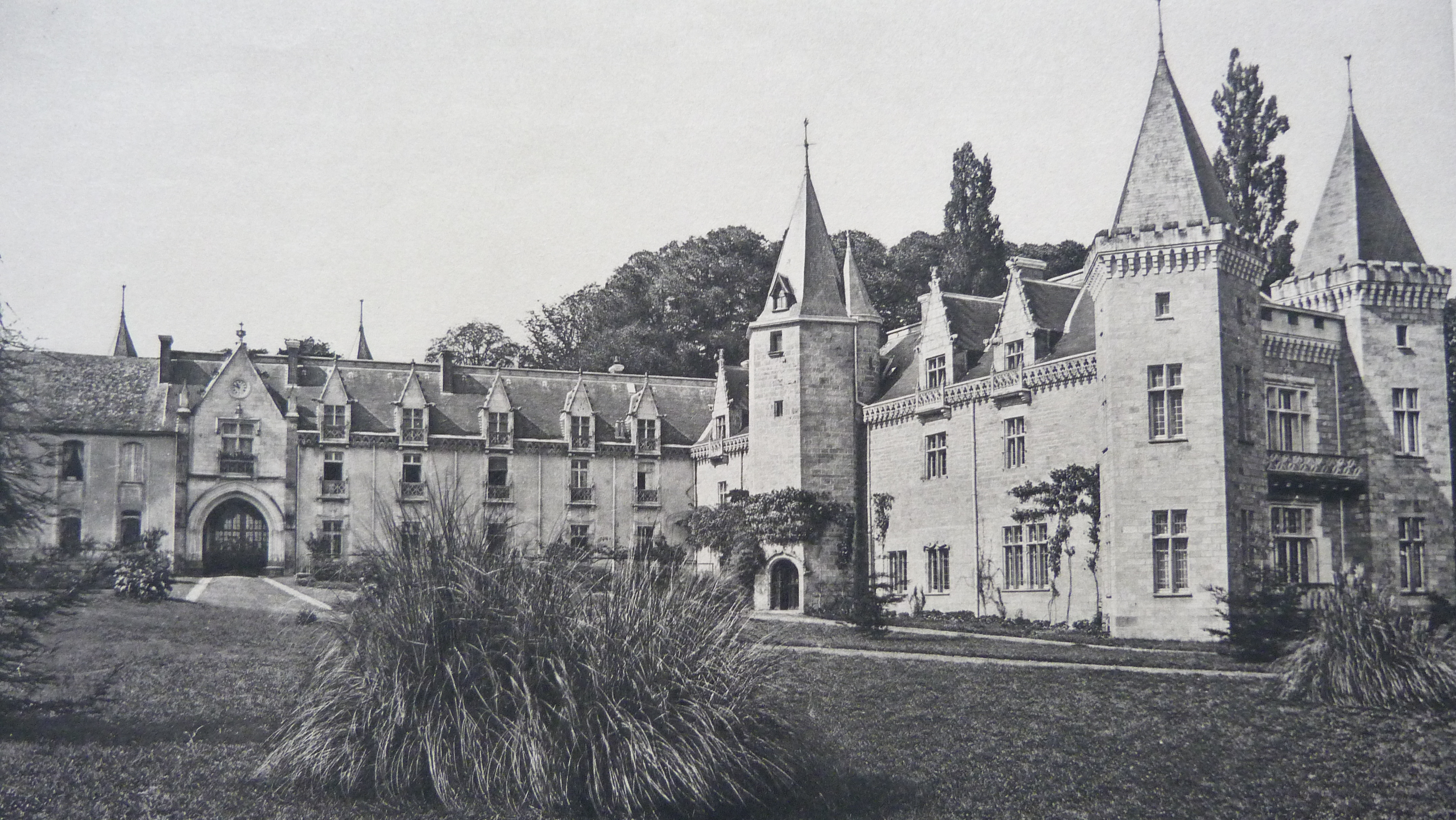
The lords of Kaer had been rough companions in the past; they took part in the duchy’s first struggles.
Normand, Lord of Kaar or Keraar, parish of Locmaria-Kaar, is mentioned in an account of Duke John the Roux in 1267. Jeanne died in 1240, abbess of Saint Sulpice de Rennes (3) Nobiliaire Breton, Pol de Courcy. Cayot-Délandre, study on the Roman roads of Morbihan.
In 1341 Henry held Montfort and was his ambassador to England in 1360. In 1364 he commanded a portion of his army, and finally was the adviser to JohnV. He appeared as a doctor of law and probably died as Canon of Treguier. The lineages of these proud knights passed to the female line.
Jean de Chateaugiron, lord of Oudon, had married Jeanne de Malestroit in her first marriage. In 1347 he took charge over the lordships of Malestroit and Largoet. A widower with two sons, he remarried Jeanne de Kaar, the last of her line, and then Jeanne de Dol (4): Genealogy of the Sires of Malestroit, by Father Le Méné (société polymathique du Morbihan, 1st s. 1886) and archives of Morbihan. He had witnessed the battle of Auray in 1364 from the ranks of Charles de Blois’ army and had been taken prisoner.
From his second marriage, two sons were born, one, Jean, the founder of the Malestroit-Kair branch; the other, Thibaud, Bishop of Treguier in 1378 and Quimper in 1383-1408.
It was only John’s grandson, John III of Malestroit, who became the owner of the Plessis by marriage to Jeanne Trémédern. He left it in 1442 to his eldest son, who united it with the Keramburg fiefdom.
Claude de Malestroit, married to Jeanne-Julienne de Treal, obtained in 1552 the elevation of Kerambourg as Viscount and Kaer as a barony. The Kaer barony (1) extends to the parish of the Bishopric of Vannes, the ruined chateau and manor house is located near the said village of Kaer. The Lord was Viscount of Ker-an-Bourg, Lord du Plessis of Kaer; the manor house and accommodation of the lordship is located in the parish of Crac’h under the jurisdiction of Auray.
He was still lord of Beau-cours, Beaumont, Tremédian and many lands held in the estate of Plumel, Mendon, Guervillic, Cot-Goal, Carnac and Guerbéran and enjoyed the right of law in and beyond the jurisdiction – in short, all lordly duties of Baron and Chastelain. (L.P. du Paze.) His two sons, John VII and René, died without descendants and their sister inherited the family property. She had not borne a child from her first marriage to Nicolas de Dennée, lord of the Motte of Gennes. In her second marriage to René de Montalais, she died in 1594, leaving a son, Mathurin, who sold the Plessis-Kair in 1639 to Jacques Barrin de la Galissonnière, who, four years later, sold it to René Riant de Galisson.
The land was owned by John Augustus, then Armand Le Meuneust, from 1718 to 1727, when it was bought by Paul de Robien (2): (Paul-Celeste-Christophe de Robien was appointed mortar president of the parliament of Rennes in 1750), left vivid memories as a man of science and work whose intriguing writings are kept in Rennes.
Robien’s president had issues with Messir Jarno, rector of Crac’h, about the right of supremacy he claimed over the parish church of Saint Thuriau. There was a trial, but no solution could be found.
At the time of The Revolution, Guy-René-Charles-François d’Andigné de la Chasse, who had married Louise-Joseph de Robien, owned the Plessis, which was sold nationally.
After successively belonging during this century to the Cauzique family and Mr. Liazard, the castle and the surrounding lands were purchased some twenty years ago by Mr. Caillot, who renovated the ancient abode from its ruins and turned it into a magnificent monument. It consists of two groups of dwellings placed in squares. One built of carved granite, is perpendicular to the river. The architect retained the polygonal tower that contained the main staircase and flanked the gable overlooking the river with two other square towers, giving a very nice effect.
The entrance gate of the castle is in the centre of the other house, the only one to be inhabited since the revolution, before the reconstruction of the building. It is broken arch, and on both sides, on the outside, are two round towers. Next to the large door is a small archway which is also oval. Above is a Renaissance-style window. On one of the gabled and mullioned windows which adorn the building, one can discern the motto of the lords of Kaer: ‘for loyalty remain’.


